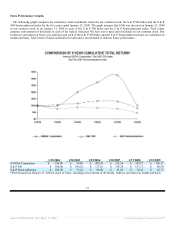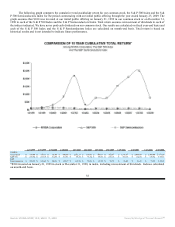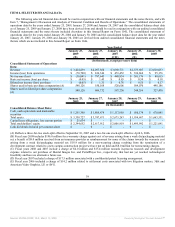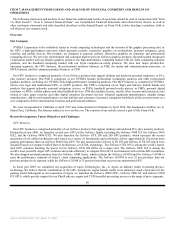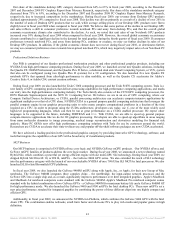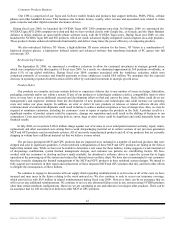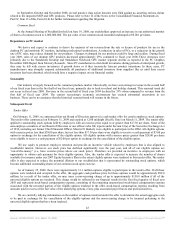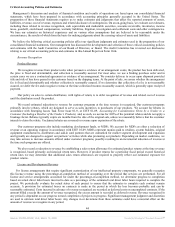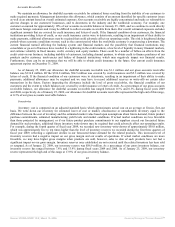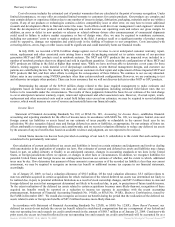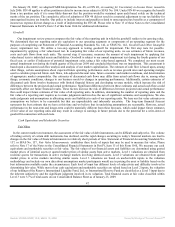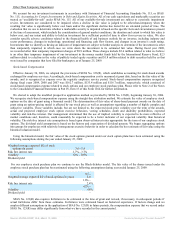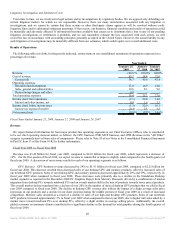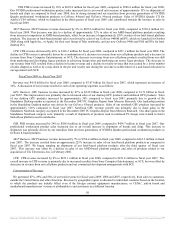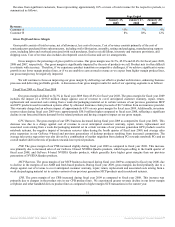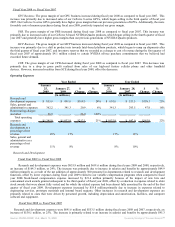NVIDIA 2009 Annual Report Download - page 55
Download and view the complete annual report
Please find page 55 of the 2009 NVIDIA annual report below. You can navigate through the pages in the report by either clicking on the pages listed below, or by using the keyword search tool below to find specific information within the annual report.
Warranty Liabilities
Cost of revenue includes the estimated cost of product warranties that are calculated at the point of revenue recognition. Under
limited circumstances, we may offer an extended limited warranty to customers for certain products. Our products are complex and
may contain defects or experience failures due to any number of issues in design, fabrication, packaging, materials and/or use within a
system. If any of our products or technologies contains a defect, compatibility issue or other error, we may have to invest additional
research and development efforts to find and correct the issue. Such efforts could divert our management’s and engineers’ attention
from the development of new products and technologies and could increase our operating costs and reduce our gross margin. In
addition, an error or defect in new products or releases or related software drivers after commencement of commercial shipments
could result in failure to achieve market acceptance or loss of design wins. Also, we may be required to reimburse customers,
including our customers’ costs to repair or replace products in the field. A product recall or a significant number of product returns
could be expensive, damage our reputation and could result in the shifting of business to our competitors. Costs associated with
correcting defects, errors, bugs or other issues could be significant and could materially harm our financial results.
In July 2008, we recorded a $196.0 million charge against cost of revenue to cover anticipated customer warranty, repair,
return, replacement and other associated costs arising from a weak die/packaging material set in certain versions of our previous
generation MCP and GPU products used in notebook systems. The MCP and GPU products that are impacted were included in a
number of notebook products that were shipped and sold in significant quantities. Certain notebook configurations of these MCP and
GPU products are failing in the field at higher than normal rates. While we have not been able to determine a root cause for these
failures, testing suggests a weak material set of die/package combination, system thermal management designs, and customer use
patterns are contributing factors. We intend to fully support our customers in their repair and replacement of these impacted MCP and
GPU products that fail, and their other efforts to mitigate the consequences of these failures. We continue to not see any abnormal
failure rates in any systems using NVIDIA products other than certain notebook configurations. However, we are continuing to test
and otherwise investigate other products. There can be no assurance that we will not discover defects in other MCP or GPU products.
Determining the amount of the $196.0 million charge related to this issue required management to make estimates and
judgments based on historical experience, test data and various other assumptions including estimated field failure rates that we
believe to be reasonable under the circumstances. The results of these judgments formed the basis for our estimate of the total charge
to cover anticipated customer warranty, repair, return and replacement and other associated costs. However, if actual repair, return,
replacement and other associated costs and/or actual field failure rates exceed our estimates, we may be required to record additional
reserves, which would increase our cost of revenue and materially harm our financial results.
Income Taxes
Statement of Financial Accounting Standards No. 109, or SFAS No. 109, Accounting for Income Taxes , establishes financial
accounting and reporting standards for the effect of income taxes. In accordance with SFAS No. 109, we recognize federal, state and
foreign current tax liabilities or assets based on our estimate of taxes payable or refundable in the current fiscal year by tax
jurisdiction. We also recognize federal, state and foreign deferred tax assets or liabilities, as appropriate, for our estimate of future tax
effects attributable to temporary differences and carryforwards; and we record a valuation allowance to reduce any deferred tax assets
by the amount of any tax benefits that, based on available evidence and judgment, are not expected to be realized.
United States income tax has not been provided on earnings of our non-U.S. subsidiaries to the extent that such earnings are
considered to be permanently reinvested.
Our calculation of current and deferred tax assets and liabilities is based on certain estimates and judgments and involves dealing
with uncertainties in the application of complex tax laws. Our estimates of current and deferred tax assets and liabilities may change
based, in part, on added certainty or finality to an anticipated outcome, changes in accounting standards or tax laws in the United
States, or foreign jurisdictions where we operate, or changes in other facts or circumstances. In addition, we recognize liabilities for
potential United States and foreign income tax contingencies based on our estimate of whether, and the extent to which, additional
taxes may be due. If we determine that payment of these amounts is unnecessary or if the recorded tax liability is less than our current
assessment, we may be required to recognize an income tax benefit or additional income tax expense in our financial statements,
accordingly.
As of January 25, 2009, we had a valuation allowance of $92.5 million. Of the total valuation allowance, $5.3 million relates to
state tax attributes acquired in certain acquisitions for which realization of the related deferred tax assets was determined not likely to
be realized due, in part, to potential utilization limitations as a result of stock ownership changes, and $87.2 million relates to state and
foreign deferred tax assets that management determined not likely to be realized due, in part, to projections of future taxable income.
To the extent realization of the deferred tax assets related to certain acquisitions becomes more-likely-than-not, recognition of these
acquired tax benefits would be reported as a reduction to income tax expense in accordance with the recent accounting
pronouncement, Statement of Financial Accounting Standards No. 141(R), or SFAS No. 141(R), Business Combinations, issued by
the FASB in December 2007. We would also recognize an income tax benefit during the period that the realization of the deferred tax
assets related to state or foreign tax benefits of $87.2 million becomes more-likely-than-not.
In accordance with Statement of Financial Accounting Standards No. 123(R), or SFAS No. 123(R), Share Based Payment, our
deferred tax assets do not include the excess tax benefit related to stock-based compensation that are a component of our federal and
state net operating loss and research tax credit carryforwards in the amount of $588.7 million as of January 25, 2009. Consistent with
prior years, the excess tax benefit reflected in our net operating loss and research tax credit carryforwards will be accounted for as a
Source: NVIDIA CORP, 10-K, March 13, 2009 Powered by Morningstar® Document Research℠


